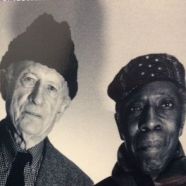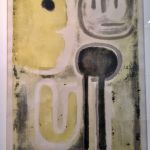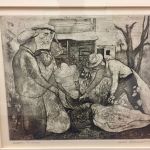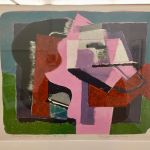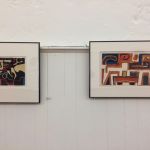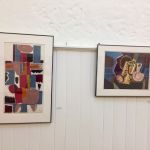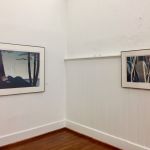Will Barnet and Bob Blackburn: An Artistic Friendship in Relief
From January 12, 2018 – March 3, 2018, the Cochran Gallery in LaGrange, Georgia, is exhibiting the prints of Will Barnet and Robert Blackburn. These works highlight their sixty-year friendship and influence on one another beginning in the 1930s through to the beginning of the 21st century. Barbara Lekatsas’s important essay on Barnet and Blackburn is excerpted below, taken from the Cochran Collection’s catalogue that was originally printed in 1997, written when both artists were still alive.
- Will Barnet and Bob Blackburn. The Fine Friends. 1952. Lithograph.
- Will Barnet. Cotton Pickers. 1935. Aquatint/Etching.
- Bob Blackburn. Heavy Forms 2nd State. 1961. Lithograph.
- (Blackburn, left) Head in Wash. Undated. Lithograph. (Barnet, right) Gladys. 1936. Lithograph.
- (Blackburn, left) Modern Times. 1984. Woodcut. (Barnet, right) The Cat. 1956. Color Lithograph.
- (Blackburn, left) Easter Print. 1967. Lithograph. (Barnet, right) Wine, Women, and Song. 1958. Color Linoleum Cut.
- (Barnet, left) Wine, Women, and Song. 1958. Color Linoleum Cut. (Blackburn, right) The Mirror (Reflections). Undated. Lithograph.
- (Barnet, left) Introspection. 1972. Color Serigraph. (Blackburn, right) Blue Window. 1962. Lithograph.
- (Blackburn, left) Grey Wood. 1963. Lithograph. (Barnet, right) Summer on Repose. 1952. Color Lithograph.
- (Barnet, left) Seventh Season. 1979. Serigraph. (Blackburn, right) Color Symphony. 1960.
- (Barnet, left) Reclining Woman. 1981. Lithograph. (Blackburn, right) Sun-Moon. 1963. Lithograph.
- Exhibit banner and Wes Cochran at the Cochran Gallery.
In many respects, the friendship of Will Barnet and Bob Blackburn fits within the scheme of other friendships in the arts: ships on parallel journeys that occasionally intersect, slow down, dock in the same ports, they then proceed on their separate courses. Braque explaining his relationship to Picasso, wrote, “in spite of our very different temperaments, we had a common idea . . . Things were said between us in those years that cannot be said again . . . no one would understand now . . . We were like two mountain climbers roped together . . .” (Dora Valier, “Braque, la Peinture et Nous,” Cahiers d’Art, XXIX [Paris: 1954], 13-15). Will Barnet and Bob Blackburn have passed their golden anniversary together as friends and collaborators. Their relationship is layered and complex, best embodied in terms of their parallel courses and artistic interaction. It is a relationship where influences and affinities seem to blend into each other so that it is difficult to tell one from the other.
The New York that drew Barnet and Blackburn together was one coming out of the Depression under New Deal progressivism. This was a type of enforced socialism in the interest of capitalist recovery. The romantic significations attached to labor and machinery, which form the myth of many of the murals glorifying workers in public buildings of the period, attest to the force of the belief in the value of work. These significations stand in sharp contrast to nineteenth-century European romantic art, with its reaction against work and the glorification of idleness and wandering—which, despite the emergence of Realism toward the latter part of the century, continued to fuel most modern movements from its scattered embers. The pastoral ideal also linked Romanticism to Classicism and its view of art as a realm apart from life, an idealized space created as a durable counterpoint to corrosive nature (or as Horace defined it, “ars longa, vita brevis” ), yet having sufficient sensual references to create a counter-world made up of elements that the real world denies.
By the twentieth century, the “romantic” feeling had shifted somewhat from nature to the machine. The machine and its environment, the city, became objects of mythic power. The Euclidian quality of the modern environment, with its geometric schemes and grid-like architecture, was a celebration of human design over organic forms.
The labor class in America rose in status as white-collar business ventures crashed. In Europe, the dandyism of bohemian life signified a reaction by artists against the meaning of work, a means of resistance to bourgeois productivity and mechanically-reproduced commercial products. Gauguin and Van Gogh, under the guide of “primitivism,” reflect a longing for escape from a society based on materialism and its class contradictions and insincere ethos. The artist’s status as a materially impoverished but spiritually rich aristocrat serves an interesting double function: on the one hand, it satisfies his middle-class audience’s secret longing to step into aristocratic status and achieve new levels of aesthetic enjoyment and refined contemplation; on the other hand, it enables the audience to step down to primitivist sensuality. Yet the middle-class public’s simultaneous contempt toward overvaluing of aesthetic experience (intellect/sensibility) over empirical utilitarian objectives (action/production), as well as a high value placed on sublimation and repression in social life, creates a high-risk venture for the artist, where art has to prove its ability to convey the contradictory experience of industry and leisure simultaneously.
Craftsmanship proves that the artist is the worker rather than an indolent dreamer. If he or she can convey the experience of workmanship, then the audience will be released to experience the pleasure of expression, contemplation, even idleness.
Printmaking in this respect becomes a genre full of possibilities and contradictions. Not as elite as painting, it nonetheless remains a process based on craftsmanship and pre-industrial techniques, that also allows the artist to control the means of production, as well as dissemination, of the print. As Michel Melot writes in History of an Art: Prints (New York: Rizzoli, 1981), the printmaker had to create a place for himself in the social order:
It was in his personality that this initial contradiction had to be resolved, and that is why such composite qualities were expected of him: he had to be both “creator” and “craftsman,” both “intellectual” and annual “worker.” The personality of the engraver would always oscillate between workman and artist. (page 41)
In America, such federal programs as WPA (Works Project Administration) and FAP (Federal Art Project) in the aftermath of the 1929 crash fostered workshops which welcomed artists from all walks of life, providing models for subsequent ateliers that would operate on the same principle as the painter’s studio, offering opportunity for collaboration and innovation. Combining a unique utopian blend of socialism and individualism, the political system invited artists to lend a hand to shape a new America. It is to the thirties that we owe the Harlem Renaissance and the flowering of Afro-American art, as well as the embracing of modernist and avant-garde trends from Europe. The ideal of democracy and the fashion for egalitarianism changed the spirit if not the letter of the day. The leveling aided by the Great Depression was the key to the collapsing of distinctions, even if temporarily, of the class structure. It also gave a stronger impetus to Social Realism in America than in Europe, where art continued its bold development away from the figure and from Realism. Only in the 1940s with the formulation of Abstract Expressionism did an ideological insistence on pure abstraction come to dominate American art.
Will Barnet and Bob Blackburn represent artistic evolutions which, while seriously fueled and enhanced by Paris movements, reflect particularly American journeys. Interestingly, both stay within the bounds of the formal innovations of the Paris school, celebrating flatness as the key feature of any possible credo that might underlay their formal philosophy. In this respect, printmaking becomes a tool of stunning flexibility leading both artists to discoveries about form, color, and surface, ground and figure. In the case of Will Barnet, the printmaking techniques inform the painting, keeping it rigorously flat even when it explores the figure. Bob Blackburn, in contrast, adheres to the language and possibility offered by Cubism. His prints are still-lifes, engraved collages, compositions created out of geometric forms, intense hermetic explorations of diaphanous and opaque surfaces of color and shape.
Will Barnet, the older of the two artists by nine years, was born in 1911, in Beverly, Massachusetts. He bears the burden of the “mentor” in the relationship, for the first serious encounter between the two men was one between instructor and pupil, when Bob Blackburn received a School Art League Award and an Art Students’ League Working Scholarship for study at the League—a scholarship that was due in large measure to Barnet, who by 1934 had become the official printer there. At twenty nine years old, Barnet had already acquired a rigorous background in art. Not only had he benefited from a very early interest in drawing that let him to haunt every museum and library between Beverly and Boston, but also he had studied at the School of the Museum of Fine Arts in Boston, which modeled its classes along the lines of those at the classical European academies.
Barnet’s home environment had also set up a basis for evolution rather than rebellion. His father, an immigrant who worked long hours as a skilled mechanic in the main factory in town, found time to create a hothouse for tropical plants and birds—perhaps also triggering his son, Will, at age twelve, to mimic him by setting up a studio in the basement. Hard work, the spirit of solitude, and a love of experience that would lift him beyond the real, naturally led the boy to art. His parents let him find his own way, supporting him when it was possible. He won a scholarship to study at the Art Students’ League in New York, where he began the study of lithography with Charles Locke. He mastered woodcutting and lithography, reasoning that he might find a job as a cartoonist for a newspaper in the manner of Honore Daumier, one of his favorite artists. He soon started to publish some of his satirical prints, but also painted signs and subsequently taught at the League in order to make a living. Teaching soon became a mission, however, as Barnet sought to emphasize the importance of ideas in developing a coherent approach to aesthetics.
Teaching was also to become a mission for Bob Blackburn, whose early background shows none of the secure moorings of Will Barnet. Born in Summit, New Jersey, in 1920 and raised primarily in Harlem, his family forced to go on public assistance and scrounge to survive, Blackburn had little to foster his creativity at an early age. Only later with the growth of federal programs in the aftermath of the 1929 crash would a window of opportunity open for him. The Harlem Community Arts Center at 125th Street was one such program established under the WPA. Blackburn attended classes there while still a high school student, and was introduced to lithography by Riva Helfond. There he came into contact with other Afro-American artists and writers, such as Norman Lewis, Selma Burke, Augusta Savage, Langston Hughes, and Richard Wright. He shared a studio adjacent to the Uptown Arts Center with Jacob Lawrence, Romare Bearden, Ronald Joseph, and Claude McKay.
The socio-economic backgrounds of Barnet and Blackburn, the different stakes that race created for each, and the family matrix out of which they evolved to a large degree provide the enigmatic impetus for the aesthetic direction each was to take. Their emergence as artists is framed by the two World Wars and their social consciousness honed by the Great Depression. In the case of Blackburn, there was also the persistent reality of racism. But the subtle basis and tension of their interaction relies on the specific difference of their family backgrounds and how they come to reframe the ideas of family, fatherhood, friendship, social group, tradition, institutions, and monumentality itself. In the work of Barnet, family and home serve as recurring themes in both prints and paintings; nature is the other great underlying thematic base. Both the figurative and the abstract works issue from these two sources. Barnet’s family is his oasis. As with the thematic and abstract evolution of Picasso, Barnet finds endless inspiration in his wife and children, their cats, the patterns of the house, the doorways, the front steps, the cracks in the sidewalk. The grand expanses of nature lead him easily to flat and monumental abstract works, closely allied to some of the flat, clean compositions of geometric painting. He can be a father without ambivalence, a teacher, a fellow-artist, evolving in the belief that the society he lives in, despite its troubles, can be improved and can even provide utopian pleasures in its day-to-day details and quiet unfolding. His faith in life’s innate worthiness always brings him back to the human and natural form, no matter how abstracted. In this respect there is a classical strain in his modernism, for the aim of the image is to valorize life and introduce a space where the hidden interiority of things becomes manifest through qualities of form—light, space, color, and so on.
Blackburn’s task was far more Promethean given the fact that he was Afro-American and poor. He has said, “America denied me every opportunity to be an intellectual” (Lekatsas, interview, New York City, July, 1995 ). His art is exquisitely intellectual, however, proving that he managed to create opportunities for himself despite this belief. The Printmaking Workshop, founded by Blackburn with the help of Barnet and others, became Blackburn’s means of creating a social milieu made of artists. It would serve as an alternative support system, the group within which his own art could develop, but also would satisfy his social conscience by constructing what Blackburn termed an “institution designed to give.” As the master printer and director of the foremost artist-controlled printmaking workshop in New York, Blackburn executed the prints of Romare Bearden, Grace Hartigan, Jasper Johns, Robert Motherwell, Larry Rivers, among many others. He also taught printmaking to several generations of artists, thus becoming in himself that “institution designed to give.” As a result, the volume of his own work suffered. For Blackburn then, the idealized space that art ultimately represents conflicts with his need to be socially active and to serve the community in some capacity. Despite the connectedness of being the master printer and director of the Printmaking Workshop, and being a printmaker himself, these roles vie with each other and influence the aesthetic goals of Blackburn, who as artist uses the print to escape the real and to express an intellectual order free of the imperfections of social and political reality.
Bob Blackburn’s hermetical character emerges from the paradoxes that erupt out of the conflicting desires to be social and politically-minded versus the utopian, occult opportunities of art. The philosophically pure domain of abstract forms that his prints reflect indicates a love of harmonious arrangement. His works thus represent a pristine, dehumanized space characterized by hermetic compositions that relate the artist’s underlying need for perfection and order—which can only occur, after all in art.
What Barnet and Blackburn share in their compositional predilections is a love of the the two-dimensional space and its flatness, as well as the frontal attack. Their compositions are clean and contained, although those from the early years, particularly Barnet’s, show some of the influence of German Expressionism. Most of the prints seem to represent the type of modernist classicism embodied by Cubism.
The prints in the Cochran Collection accurately represent the evolution of the two artists’ careers as printmakers. Barnet’s prints, ranging chronologically between 1935 and 1982, give us a glimpse of his steady evolution over a five-decade span. The prints of Blackburn do not submit easily to a historical reading or evolution, most being from the 1960s, but they can be regarded statistically in terms of what compositional features repeat and the moods that these compositions invite. Will Barnet has said, “In graphics, I was trying to express myself as a painter . . . in my graphics classes I actually taught painting in a sense . . . many people came to study composition with me more than graphic art” (Robert Doty, Will Barnet [New York: Harry Abrams, 1984), 25). In the prints of the 1930s, despite his adherence to some form of realism, we see Barnet already experimenting with a variety of abstract elements to enhance and dramatize the figure. These prints can be termed “realistic,” in terms of their adherence to a favorite theme of Social Realism—the plight of the worker. Yet one notices the influence of German Expressionism and Byzantine iconography working dynamically within these compositions.
***
Both Will Barnet and Bob Blackburn, in their parallel and intersecting courses, collaboration, and friendship, have managed to transform themselves through art into visionaries. They accomplish this without forgetting to give back to society, not only in the power of their visions and formal capabilities as reflected in their compositions, but also in their capacities as teachers and mentors to generations of artists.
That sense of social responsibility was part of the legacy of the 1930s, when Barnet and Blackburn both set out to become artists. At the same time, their art seduces the spectator with its intimations of a sublime realm of forms emerging into relief from the humble concrete ground of the print.
Barbara Lekatsas
Hofstra University, New York
1996
BIBLIOGRAPHY
Cole, Sylvan, Jr., editor. Will Barnet (1932-1972). New York: Associated American Artists Gallery, 1972.
Cummings, Paul. A Dictionary of American Artists. New York: St. Martin’s Press, 1971.
Doty, Robert. Will Barnet. New York: Harry Abrams, 1984.
Johnson, Una E. Will Barnet: Prints 1924-1964. New York: The Brooklyn Museum, 1965.
Kraskin, Sandra and Hollister, Barbara, editors. The Indian Space Painters: Native American Sources for American Abstract Art. New York: Baruch College, 1991.
Melot, Michel, Griffiths, Antony, Field, Richard S., and Beguin, Andre, editors. History of an Art: Prints. New York: Rizzoli, 1981.
Valier, Dora. “Braque, la Peinture et Nous,” Cahier d’Art, XXIX. Paris: 1954.


